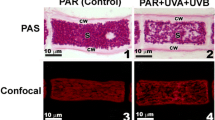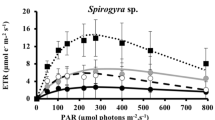Abstract
The marine algal species in the Baltic Sea are few due to the low sea water salinity. One of the few species that can be found is Fucus vesiculosus. Even this species is affected by the low salinity and becomes smaller in size in the Baltic. In present work the photosynthesis of F. vesiculosus in the northern Baltic (Bothnian Sea) was compared to the photosynthesis of F. vesiculosus in the Atlantic. Oxygen evolution was measured before and after exposure to 2.3 W of UV-B (280–320 nm) radiation for 5 h, as well as after 48 h recovery in low light. The plants were kept in their own sea water salinity as well as in a changed salinity, this to examine possible correlations between salinity and photosynthesis. The results show a significant higher initial maximal photosynthesis (P max) for Atlantic plants (10.3 nmol O2 g−1 FW s−1) compared to Baltic plants (4.0 nmol O2 g−1 FW s−1). The Baltic plants were found more sensitive to UV-B with a 40–50% decrease of P max as well as a lower degree of recovery (60–70% compared to 75–95% for the Atlantic plants). The higher salinity (35 psu) had a positive effect on the Baltic F. vesiculosus with increased P max as well as increased tolerance to UV-B. The lower salinity (5 psu) had a negative effect on the Atlantic plants with a decreased P max as well as a lower tolerance to UV-B. Pigment content was found higher in Atlantic F. vesiculosus. The pigment content decreased then the Atlantic plants were transferred to 5 psu. The concentration of Chl a as well as the total content of violaxanthin, diadinoxanthin and zeaxanthin in Baltic plants increased when transferred to 35 psu. The Atlantic F. vesiculosus can not survive the low salinity in the northern Baltic (died within 8 weeks). It is likely that a long time acclimation or adaptation to low salinity has taken place for F. vesiculosus in northern Baltic. If this is an ecotypic or genotypic development it is too early to say.
Similar content being viewed by others
References
Bäck S, Collins JC, Russel G (1992a) Comparative ecophysiology of Baltic and Atlantic Fucus vesiculosus. Mar. Ecol. Prog. Ser. 84: 71–82.
Bäck S, Collins JC, Russell G (1992b) Effects of salinity on growth of Baltic and Atlantic Fucus vesiculosus. Br. Phycol. J. 27: 39–47.
Bischof K, Hanelt D, Wiencke C (1998a) UV-radiation can affect depth-zonation of Antarctic macroalgae. Mar. Biol. 131: 597–605.
Bischof K, Hanelt D. Wiencke C (2000) Effects of ultraviolet radiation on photosynthesis and related enzyme reactions of marine macroalgae. Planta 211: 555–562.
Bischof K, Hanelt D, Tüg H, Karsten U, Brouwer PEM, Wiencke C (1998b) Acclimation of brown algal photosynthesis to altraviolet radiation in Arctic coastal waters (Spitsbergen, Norway). Polar Biology 20: 388–395.
Dawes CJ, Bird K, Hanisak MD (1988) Physiological responses of transplanted populations of Sargassum pteropleuron grown in Florida. Aquatic Bot. 31: 107–123.
Kalvas A, Kautsky L (1998) Morphological variation in Fucus vesiculosus populations along temperature and salinity gradients in Iceland. J. Mar. Biol. Assn. UK 78: 985–1001.
Karsten U, Bischof K, Wiencke C (2001) Photosynthetic performance of Arctic macroalgae after transplantation from deep to shallow waters. Oecologia 127: 11–20.
Koch EW, Lawrence J (1987) Photosynthetic and respiratory responses to salinity changes in the red alga Gracilaria verrucosa. Bot. Mar. 30: 327–329.
Nygård CA, Ekelund NGA (1999) Effects of lead (PbCl2) on photosynthesis and respiration of the bladder wrack, Fucus vesiculosus, in relation to different salinities. Wat. Air Soil Polln. 116: 549–565.
Russell G (1987) Spatial and environmental components of evolutionary change: Interactive effects of salinity and temperature on Fucus vesiculosus as an example. Helgol. Meeresunters. 41: 371–376.
Russell G (1988) The seaweed flora of a young semi-enclosed sea: The Baltic. Salinity as a possible agent of flora divergence. Helgol. Meeresunters. 42: 243–250.
Tropin IV, Radzinskaya NV, Voskoboinikov GM (2001) The influence of salinity on the rate of dark respiration and structure of the cells of brown algae thalli from the Barents Sea littoral. Biol. Bull. 30: 40–47.
Waern M (1952) Rocky shore algae in the Öregrund archipelago. Acta Phytogeogr. Sueca 30: 1–298.
Wallentinus I (1979) Environmental influences on benthic macrovegetation in the Trosa-AskÖ area, northern Baltic proper. II. The ecology of macroalgae and submerged phanerogams. Contrib. AskÖ Lab. Univ. Stockholm, 25: 1–210.
Wright SW, Jeffrey SW, Mantoura RFC, Llewellyn CA, Bjørnland T, Repeta D, Welschmeyer N (1991) Improved HPLC method for the analysis of chlorophylls and carotenoids from marine phytoplankton. Mar. Ecol. Prog. Ser. 77: 183–196.
Author information
Authors and Affiliations
Corresponding author
Rights and permissions
About this article
Cite this article
Nygård, C.A., Ekelund, N.G.A. Photosynthesis and UV-B Tolerance of the Marine Alga Fucus vesiculosus at Different Sea Water Salinities. J Appl Phycol 18, 461–467 (2006). https://doi.org/10.1007/s10811-006-9050-x
Published:
Issue Date:
DOI: https://doi.org/10.1007/s10811-006-9050-x




